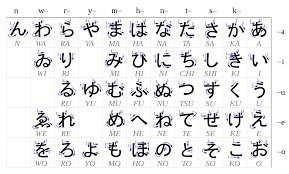|
|
| |
|
|
| |
|
|
|
|
| |
 |
| Table showing
hiragana characters. |
Hiragana
Hiragana are part of the Japanese writing system.
Japanese writing normally consists of kanji which are
used for the main words in a sentence, and hiragana
which are used for the little words that make up the
grammar (in English these would be words like “from” and
“his”). Hiragana is also used for the endings of some of
the words.
Hiragana is a syllabary, which means that each hiragana
character stands for a syllable. It is therefore
different from a language such as English which uses an
alphabet in which most of the letters stand for one bit
of sound (phoneme). There is also another syllabary
called katakana which is mostly used for foreign words
and names. The two kana systems are quite easy to learn,
but kanji takes years of practice. In contrast, the kana
systems can be learnt in two weeks. |
|
In the past hiragana was considered as women's writing,
while men wrote in kanji. Since kanji suit well in
Chinese but poorly in Japanese, it was the women who
wrote the first Japanese books, poems and songs. Later
the Buddhist clerics, such as Rennyo (d. 1498), wrote in
hiragana to make the religious message easy to
understand and everyone to read.
Sometimes the whole of a text may be written in hiragana
to make it easy. This would be used in books for young
children, or for students starting to learn Japanese, or
when writing the lyrics for songs underneath the music
where it is important to show how the words fit the
music. Some rare or strange kanji may also have
so-called furigana characters above it. They are
hiragana which show how the kanji is to be pronounced. |
|
In Hiragana each character (kana) is either a vowel
(such as "a": あ); a consonant followed by a vowel (such
as "ka": か); or, at the end of a syllable, an "n": (ん),
although sometimes this sounds more like an “m” or “ng”.
As an example of how the grammatical endings are used we
can take the verb “to eat” which is食べる (taberu). Here
the main part of the word “eat” (pronounced “ta” in this
case) is the kanji 食. The other two syllables: “be-ru”
are in hiragana (べる). To say “I ate” or “you ate” etc.
you would say “tabemashita”, written食べました (“be-ma-shi-ta”
is written in hiragana). |
|
Notice that the sound “hu” is unknown in Japanese, so ふ
is pronounced “fu” with an “f” which is blown lightly.
To write the voiced sounds for “g”, “d”, “z” and “b” two
little lines called a dakuten (゛) are added after a
character starting with the unvoiced sounds “k”, “t”,
“s” and “h”. A circle, (゜), is added after a “h” for the
sound “p”. For example: は gives the sound “ha”; ば gives
the sound “ba”; ぱ gives the sound “pa”.
Sometimes when words are joined together to make
compound words, a sound changes from unvoiced to voiced.
For example: “hana”: はな (nose) + ち“chi” (blood) becomes
はなぢ “hanaji” (nosebleed)
Some Japanese syllables which have sliding sounds add a
small version of the hiragana for ya, yu or yo (ゃ, ゅ and
ょ) This is called “yōon”. For example: “sha” sounds like
“shi”+”ya” so “densha” (a tram) is written でんしゃ. A small
“tsu” っ called a “sokuon” shows a doubled consonant:
“Nippon” (Japan) is written にっぽん. Without the small “tsu”
the first syllable would sound like the word “knee”.
A student starting to learn to write Japanese can start
with hiragana or with katakana. Hiragana is the basis of
learning Japanese script. However, for someone who is
about to visit Japan and just wants to be able to
recognize a few words, katakana will be more useful as
it will help to read many of the road signs, shop names
and the names of things on restaurant menus. |
|
|
 Kiddle: Hiragana Kiddle: Hiragana
Wikipedia: Hiragana |
|
|
|
|
|
|
|
|
|
|
|
|
|
|
|
|
Search Fun Easy English |
|
|
|
|
|
|
|
|
|
|
|
|
|
|
|
About
Contact
Copyright
Resources
Site Map |